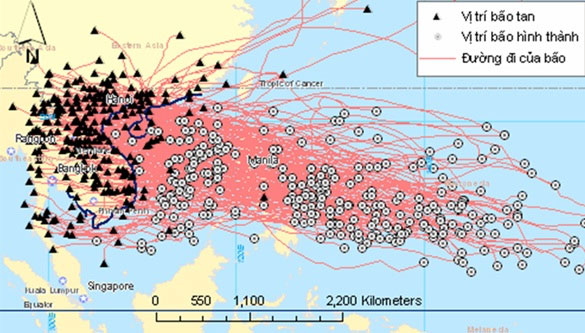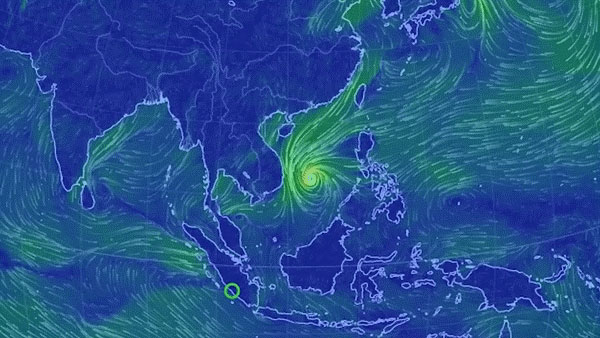2018 hurricane season: Abnormal displacement storms, need to be wary of 'less sensitive' areas
The central region has always been considered as a 'typhoon', while the South has rarely had storms. However, the trend of storms is gradually shifting to the south and appears in areas where storms rarely occur.
Abnormal transfer?
Storm rule appeared in the year starting from the North and then moving to the South. In these regions, the Central region is considered by many people as 'umbilical cord', while the South rarely has storms.

As a rule, early storms often point to the North, then gradually shift to the South of Vietnam.
Prof. Dr. Phan Van Tan, Department of Meteorology and Oceanography, Natural University, Hanoi National University explained that the Central view is always the storm by storm in the Middle region in the autumn period. and early winter, when the tropical convergence band moves into this area.
Once a storm occurs, accompanied by cold air, the interaction between tropical and temperate weather systems plus the role of topography often causes heavy rain. The river in the Central is short and steep. If heavy rains occur, it is easy to cause big floods causing heavy losses. This is not to mention the impact of a series of hydroelectric dams upstream of rivers. Therefore, the imprint of the "Central region is always the typhoon" is not the Central region with more storms than the North, but the consequences of the storm.

The river in the Central is short and steep.If heavy rains occur, it is easy to cause big floods causing heavy losses.(Illustration).
In the South, there are very few storms because of the last months of the year, in addition to the effects of cold air (although the Southern region is not as cold as in the North), the tropical convergence band gradually weakens and moves down to the South. bridge. Conditions for forming storms (sea surface temperature above 26.5 degrees Celsius, .) are not favorable, so the southern region often has very few storms.
However, at present, there is a lot of information that storms tend to shift southward and appear more in the south. In this view, Prof. Dr. Phan Van Tan said: 'This view is based on statistics to make that statement. But it seems right.
As a result, perhaps due to climate change, the temperature of the Earth's surface in general (both sea and continent) is not uniformly heated in different regions, leading to a change in the circulation regime of the atmosphere and the ocean that consequently shifts the favorable areas for storms to form and function '.
Be wary of "less sensitive" areas
According to Prof. Dr. Phan Van Tan, before the shift of storms , leaders from central to local levels, and the media themselves need to play a pioneering role in raising awareness of the community. In the southern region, people have little or no experience to prevent and respond to storms, so they are most vulnerable to this phenomenon.

The impact of storms on the southern region of our country.
In the same view, Dr. Pham Duc Thi, former officer of the National Center for Meteorological and Hydrology (General Department of Meteorology and Hydrology), said that, with what is happening, not only is the storm strong (even super storms), storms with complicated paths, we need to watch out for storms in areas where there are few storms, such as in the south, where there has been little storm.
According to the expert who has many years of research in this area, Typhoon Linda in the past or more recent storm Damrey of 2017 is very typical evidence. The highlight of these storms is not only strong but also landed in areas where there are no frequent storms.
Dr. Pham Duc Thi analyzed: From the appearance of these storms, it posed many problems for us.Firstly , in the past, strong storms often had to take a few decades to happen, even a lifetime when people witnessed strong storms once. But now strong storms have appeared more, more intense, not waiting for a lifetime.
The storms like Linda in the past will be able to repeat whenever.Secondly , it is a matter of storm prevention and improving capacity to cope with natural disasters. We need to be prepared for storms not only in areas with storms but also areas that are less likely to affect storms.

The scene dissipated after a storm.
In addition, even in these areas, it is necessary to prepare storm prevention skills, especially to avoid subjective psychology 'no storms in this area'.
Mr. Le Thanh Hai, Deputy Director General, General Department of Meteorology and Hydrology, also said that, according to the law, there will be about 2 direct effects on the North every year, 3-4 attacks on the Central and the other side Men are very few."But this does not allow the southern areas to be subjective. Hurricane Linda in the past is a few typical examples," Hai advised.
- Atlantic Ocean faces a big hurricane season
- Are the storms this year more devastating than previous years?
- This year's storm may be more devastating
- What is a storm? How storms form and why do storms occur?
- The difference between the names of storms
- A strong hurricane number 10 with level 12 approaches the land
- Severe storms and floods in Asia, more than 600 people died and went missing
- Tet: Be wary of high-tech crime
- Big storms appear in Central America and the Caribbean
- Hurricane Melor jerked level 17 is heading into the East Sea
- 9 storms occur at the same time, experts warn of 'abnormal'
- The pilot flew straight into the eyes of super typhoon 300km / h to retrieve data
 Is the magnetic North Pole shift dangerous to humanity?
Is the magnetic North Pole shift dangerous to humanity? Washington legalizes the recycling of human bodies into fertilizer
Washington legalizes the recycling of human bodies into fertilizer Lightning stone - the mysterious guest
Lightning stone - the mysterious guest Stunned by the mysterious sunset, strange appearance
Stunned by the mysterious sunset, strange appearance